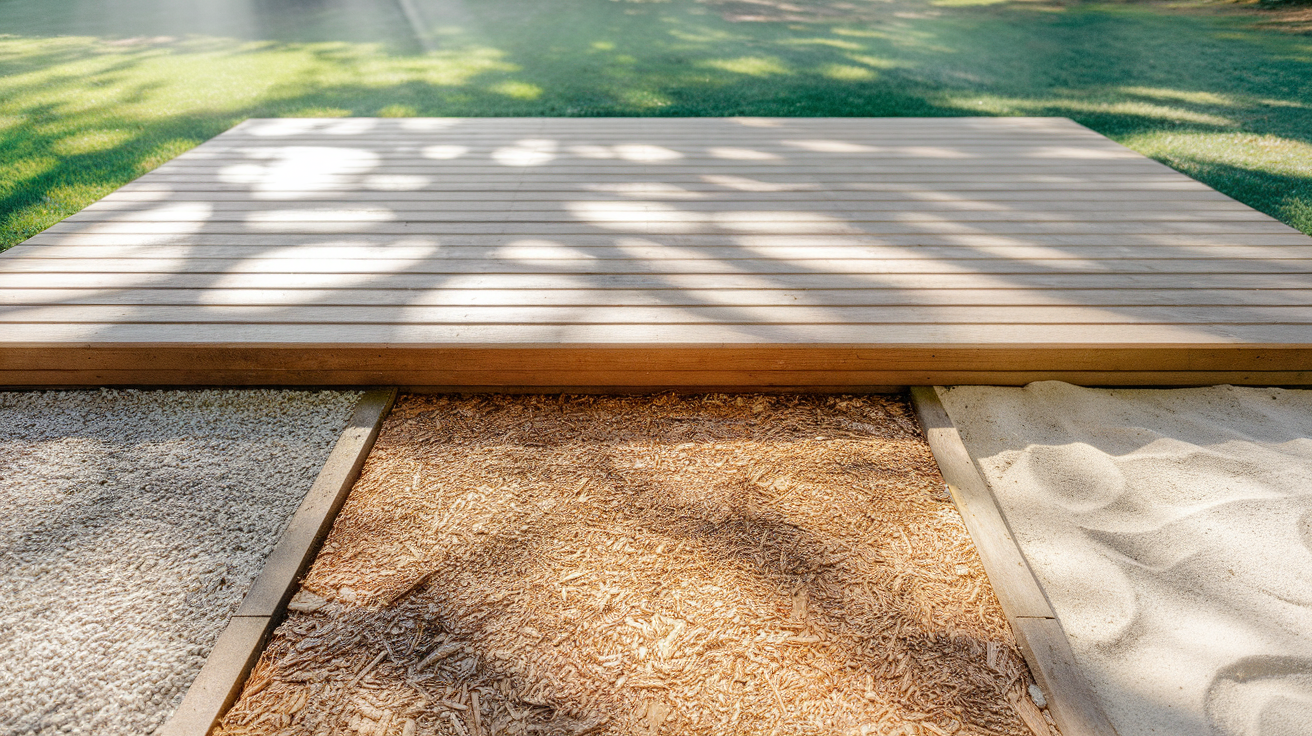When I built my deck, I didn’t think much about what to put under it. I thought the boards on top were all that mattered. But I quickly learned that the ground under a deck plays a big role.
It can help with drainage, stop weeds, and even keep bugs away. If you leave it bare, you might end up with water problems, mud, or unwanted plants. Picking the right material makes a big difference.
Gravel, mulch, and sand are three common choices, each with its own pros and cons. I’ll break them down in this post so you can see which one fits your needs.
If you want your deck to last longer and stay clean underneath, keep reading. It’s a small step that makes a big impact.
Why What’s Under a Deck Matters?

Most people focus on the top of the deck, boards, railings, and furniture. But the space under the deck is just as important. If it’s not handled properly, problems can arise quickly.
Water can pool up. Mud can form. Weeds can grow. Insects can move in. All of that can hurt your deck, your yard, and even your home’s foundation.
That’s why it’s smart to cover the ground under the deck with something that works well for your space.
What Should the Ground Be Like Under a Deck?
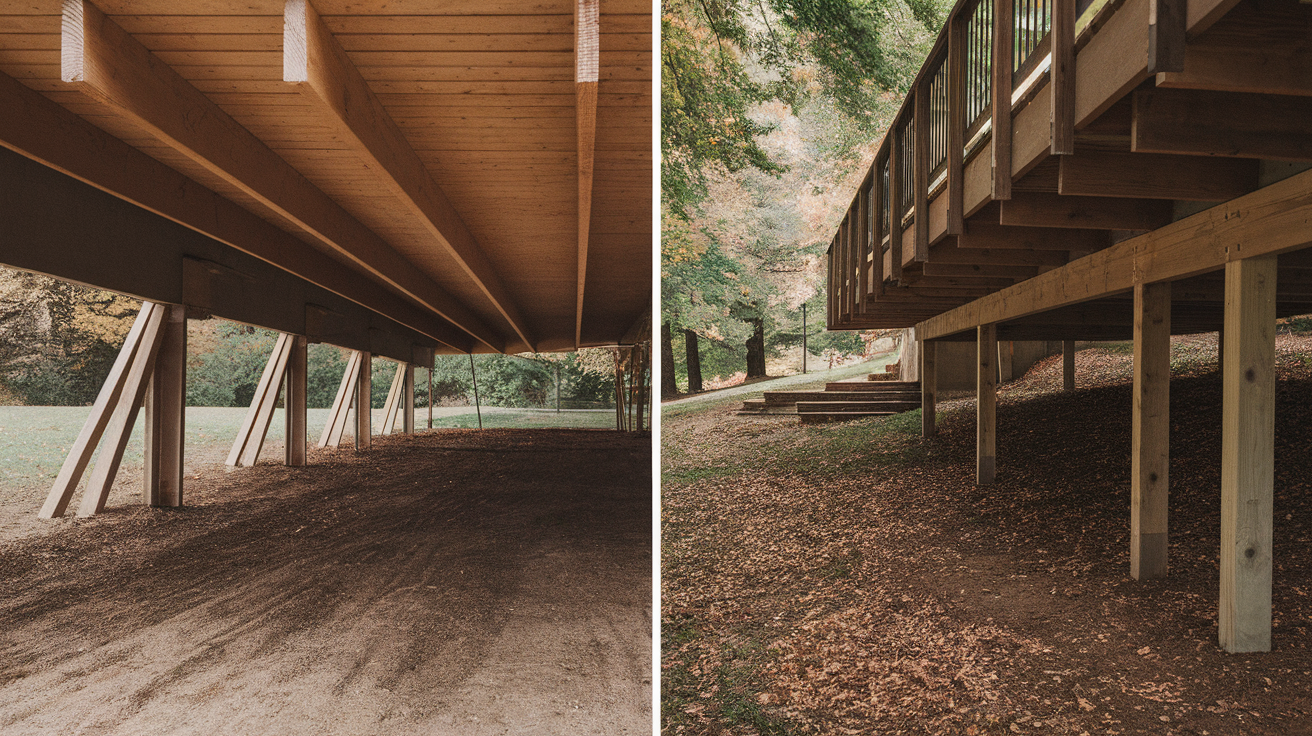
Before picking what to put under a deck, you should understand what the ground is like. A few things to check are:
- Is the Ground Flat or Sloped? If your yard is flat, water might sit there. If it’s sloped, water may run off more easily. That affects how well things like gravel or mulch work.
- Does the Soil Drain Well? Some soil drains water fast. Some hold onto water and become muddy. Clay soil, for example, holds water. Sandy soil drains fast. You’ll want to pick a cover that helps balance it out.
- Is the Area Shady or Sunny? Shady areas stay damp longer. Sunny areas dry out faster. This affects how mulch or sand breaks down or shifts.
Gravel
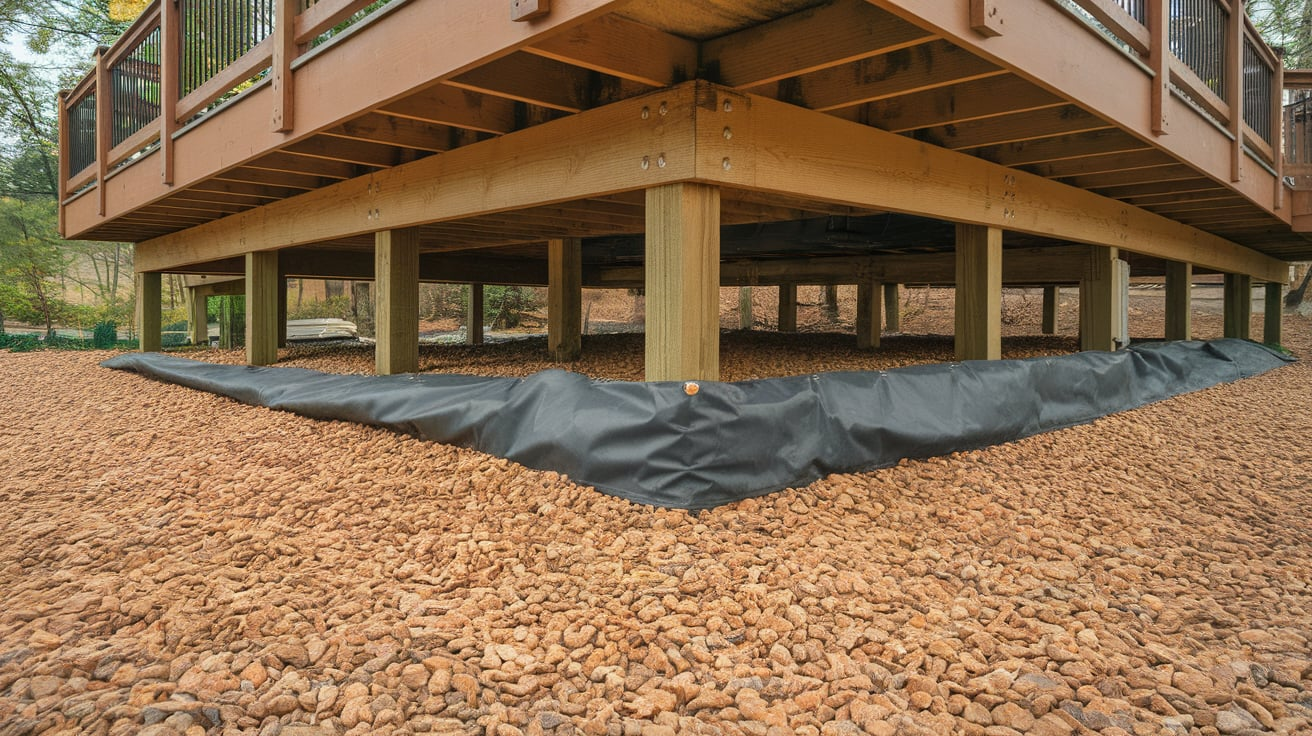
Gravel serves as an excellent ground cover for deck areas. Its popularity stems from the wide range of colors, sizes, and textures available, making it a flexible solution for different landscape designs.
Benefits of Using Gravel
- Great Drainage: Water flows through gravel easily. No standing water or mud.
- Stops Weed Growth: Gravel makes it hard for weeds to grow, especially with a weed barrier under it.
- Long-Lasting: Gravel doesn’t rot or break down like mulch.
- Good for Airflow: It helps air move under the deck, which keeps things dry.
- Looks Neat: Gravel has a clean look and doesn’t spread around like mulch.
Drawbacks of Gravel
- Can Be Hard to Walk On: Not great if you plan to use the area for storage or as a space for pets.
- May Shift Over Time: Heavy rain or foot traffic can move it around.
- Needs a Weed Barrier: If you skip the fabric, weeds can still grow up through it.
Best Type of Gravel to Use
- Crushed Stone: Good for drainage and stays in place better.
- Pea Gravel: Round and smooth, but rolls around more easily.
- Decomposed Granite: Finer gravel that compacts well.
Mulch
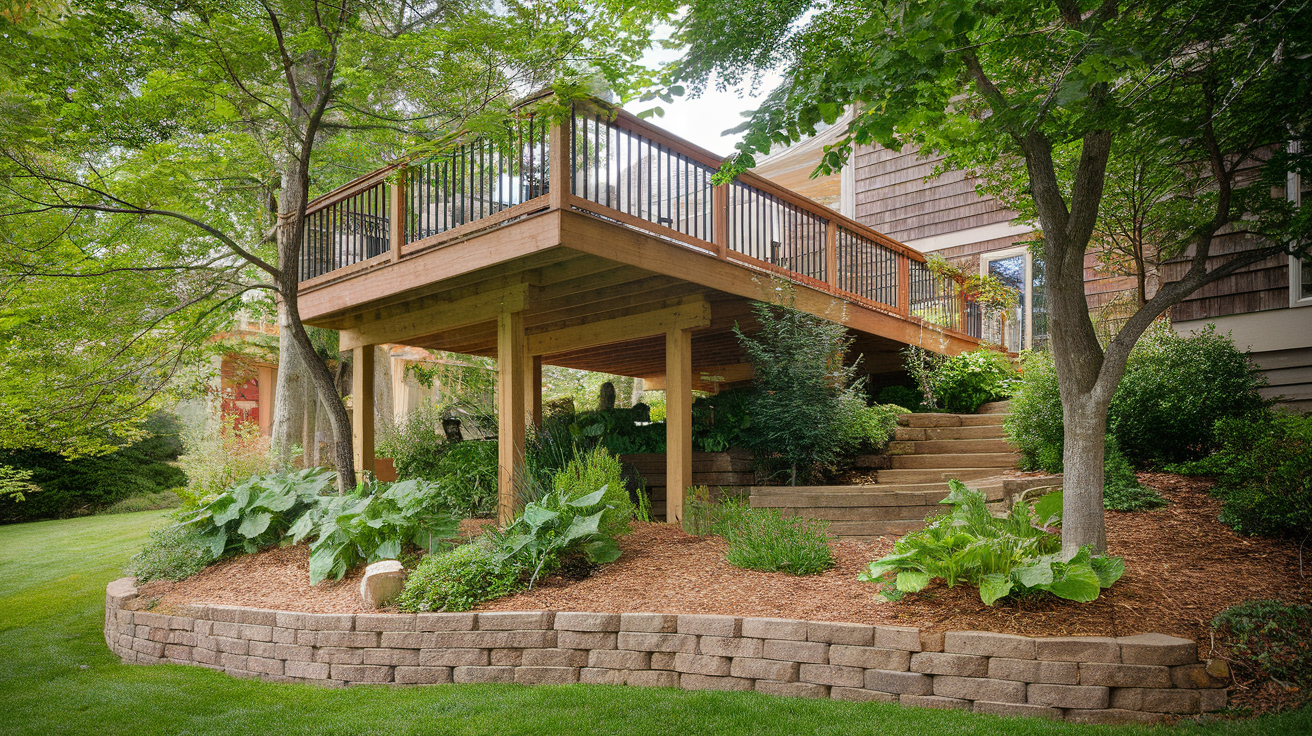
Mulch represents a versatile ground cover derived from organic plant materials. Its organic composition brings multiple benefits to outdoor spaces, creating an attractive and practical foundation.
Benefits of Using Mulch
- Easy to Spread: Light and simple to place.
- Low Cost: Often cheaper than gravel.
- Looks Natural: Blends into the yard well.
- Stops Weeds (Short Term): Mulch can block weed growth if thick enough.
Drawbacks of Mulch
- Doesn’t Last Long: Mulch breaks down over time. You’ll need to add more each year.
- Can Attract Bugs: Insects like termites and ants may hide in mulch.
- Holds Moisture: This can lead to mold or mildew under the deck.
- Not Good for Drainage: It doesn’t let water pass through as easily as gravel.
Best Mulch to Use Under a Deck
- Cedar or Cypress Mulch: These types resist bugs better.
- Hardwood Mulch: Breaks down more slowly than softwood.
Sand
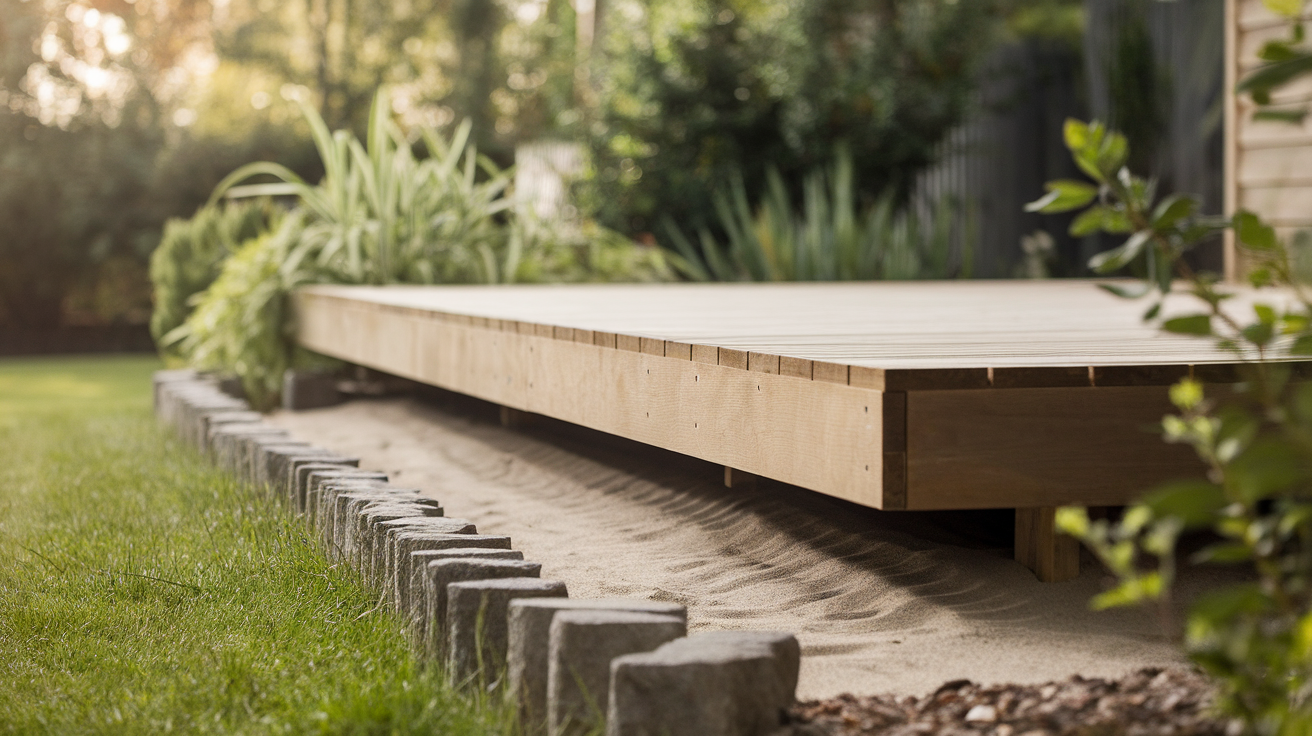
Sand represents a less traditional ground cover for deck foundations, offering characteristics that suit specific landscape conditions. Its fine, granular nature allows for precise leveling and drainage in areas with specific ground challenges.
Benefits of Using Sand
- Easy to Level: Smooth and soft surface.
- Drains Well: Better than mulch but not as well as gravel.
- Stops Some Weed Growth: Thick layers block light from weed seeds.
Drawbacks of Sand
- Can Shift Easily: Rain, wind, and animals can move it around.
- Can Wash Away: Heavy rain may carry it off.
- Can Get Messy: It sticks to shoes and paws.
- May Attract Ants: Some ants love dry, sandy soil.
Best Use for Sand
- With Pavers: Sand works well if you want to lay pavers under your deck.
- For Shallow Decks: Works better under low decks with good shade and less water flow.
Other Ground Cover Options
When traditional materials like gravel, mulch, or sand don’t meet your specific needs, several other ground cover alternatives can provide effective solutions for deck underlayment.
Landscape Fabric
This is a cloth you lay down to stop weed growth. It works best under gravel or mulch.
- Doesn’t block water
- Keeps weeds down
- Should be used with another top layer
Concrete Slab
This is more expensive, but it provides a solid, clean base.
- No weeds
- No pests
- Good for storage
Rubber Mulch
Made from shredded tires. It doesn’t break down like wood mulch.
- Lasts long
- Doesn’t attract bugs
- More costly
What to Use Under a Low Deck?
A low deck is one that’s built close to the ground, usually just a few inches to a foot high. Because there’s not much space underneath, you have to be careful about what you put there:
1. Gravel Is the Best Pick
Gravel is the top choice under a low deck. It allows water to drain quickly, keeping the area dry. It also helps stop weeds and bugs.
Since gravel doesn’t hold water like mulch does, it keeps the space under your deck cleaner and healthier. It also helps air circulate, which reduces the likelihood of mold.
Tip: Use landscape fabric under the gravel to prevent weeds from growing. A 2–3 inch layer of crushed stone or pea gravel works well.
2. Avoid Mulch
Mulch is not a good idea for low decks. It holds moisture, which can lead to rot. It also breaks down over time and may attract bugs like ants or termites.
Since there’s not much airflow under a low deck, the mulch won’t dry out quickly. That makes it worse for your deck’s wood and posts.
3. Sand Can Work in Some Cases
Sand isn’t the best, but it can be used if the area is very dry and you just need a soft surface.
Still, sand doesn’t drain as well as gravel, and it can shift around or wash away. If you do use sand, ensure the area has a slight slope to allow water to run off.
Extra Tips for Low Decks
- Check Drainage: Make sure water doesn’t pool. Grade the soil so it slopes away from your home.
- Skip Plants: Don’t plant anything under a low deck; it won’t get enough sun or air.
- Use a Weed Barrier: This prevents unwanted plants from growing under the deck.
- Leave Gaps: Ensure your deck boards have small gaps between them, allowing water and air to pass through.
What to Use Under a Tall Deck?
A tall deck gives you a lot more room underneath, usually more than 4 feet high.
This open space has better air movement and more light. That means you have more choices when it comes to what to put under it:
1. Gravel Is a Great All-Around Choice
Gravel works well under tall decks just like it does under low ones. It drains water fast and keeps the area dry.
It also stops weeds and pests from taking over. If you plan to store tools, bikes, or bins under the deck, this gives you a clean, solid base.
Tip: Use landscape fabric first, then add 2–4 inches of gravel. Choose crushed stone if you want it to stay in place better.
2. Mulch Looks Natural and Is Budget-Friendly
Mulch is suitable for use under a tall deck because air can circulate easily, and the space dries out more quickly.
It provides a soft, natural look, making it great for light landscaping or when you want the area to blend in with your yard.
Watch out: Mulch breaks down over time and can attract bugs, so check it now and then. Don’t pile it too close to deck posts or your home’s siding.
3. Sand Can Be Used for a Flat and Soft Surface
If you want a soft and level space for kids to play or pets to dig, sand can be a suitable option.
It’s easy on bare feet and doesn’t cost much. It’s not excellent at stopping weeds, though, and it can shift when wet or dry.
Use it only if the area under the deck has good drainage and stays dry most of the time.
4. Pavers or Concrete for a Finished Look
Want a clean, solid space under your tall deck? You can add pavers or even pour a concrete slab.
This is ideal for converting the area into a patio or storage space. It costs more, but it lasts a long time and needs little upkeep.
Good for: Outdoor seating, grilling stations, and waterproof storage sheds.
Extra Tips for Tall Decks
- Add a Drainage System: If water from the deck drips down, you can install a drainage tray under the deck boards to catch and direct it away.
- Create Zones: Use gravel in one area and mulch in another, depending on the space’s intended use.
- Use Edging: Keep materials like gravel or mulch from spreading by adding edging borders.
- Keep It Clean: Sweep or hose down the area periodically to prevent dirt buildup.
- Consider Lighting: A tall deck provides ample space to hang lights or install solar-powered lights for enhanced nighttime use.
Tips for Picking the Right Material
Selecting the right ground cover for your deck foundation involves carefully weighing several critical factors. Your choice impacts not just the appearance, but also the long-term performance and maintenance of your outdoor space.
| Question | Best Option |
|---|---|
| Need great drainage? | Gravel |
| Want low cost? | Mulch |
| Want long life, less upkeep? | Gravel or rubber mulch |
| Is it shady and moist? | Gravel |
| Want a soft, easy-to-walk area? | Sand or mulch |
| Worry about bugs? | Gravel or rubber mulch |
| Have a tight budget? | Mulch or sand |
Conclusion
When I first built my deck, I didn’t think much about the ground underneath. But I’ve learned it matters more than I thought.
Selecting the right material, such as gravel, mulch, or sand, can help prevent weeds, drain water effectively, and maintain a neat appearance.
Gravel is great for staying dry. Mulch looks natural but needs care. Sand works in dry spots but can shift. What you choose depends on your space, the type of soil, and how you plan to use the area.
Don’t forget to prepare the ground well and check on it periodically. A little work now saves time and trouble later.
I hope this guide has helped you determine what works best under your deck. Take a walk around your yard and see what makes sense for you. That small space can make a big difference.

